My favorite type of fish to catch is, “mahi-mahi baby”! That is what we usually say during the excitement of catching mahi-mahi. These are tropical fish that seasonally migrate thousands of miles each year. Mahi-mahi are also called the dolphinfish or dorado in Portuguese.
These bright-colored carnivores are the fastest-growing fish in the world, growing up to 1 inch per week and gaining up to 3 pounds per month. Mahi-mahi live in surface waters and eat fish, crabs, squid, and shrimp.
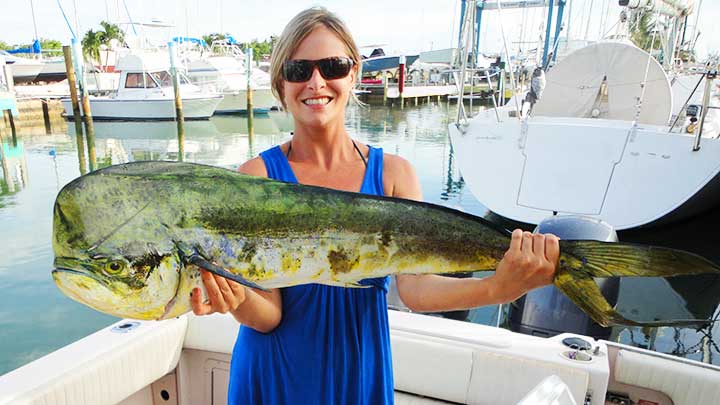
Mahi-mahi are found scattered in the open ocean generally in warmer waters near the gulf stream. The general strategy to find mahi-mahi in South Florida is to travel past the reef into blue water 200 feet or deeper in-depth but the mahi-mahi will be near the surface. Upon reaching blue water look for Sargassum Alge weed lines, debris, fish surfacing or diving birds. Once one of these is found there is a good chance mahi-mahi will be around if it is the correct time of year. When fishing for mahi-mahi it is also common to catch sailfish, marlin, tuna, tripletail, and wahoo.
Once a good fishing location is found the baits can be pitched or trolled close to surface structure or activity. A six to seven-mph troll speed is typical for mahi-mahi. This can vary based on weather conditions, types of lures, and the size of the boat. Some lures need to be in locations fish can easily spot them. This is done by placing them far back or outside of the turbulence area of the wake. Mahi-mahi can swim at over 55 mph so don’t be afraid to try faster-trolling speeds if fish are not hitting lures at slow trolling speeds.
Some boats catch three mahi-mahi all day and others catch 60 mahi-mahi. The big difference is capitalizing once one fish is caught while trolling. Keep the fish in the water about 20 feet behind the boat until a second mahi-mahi is hooked. The second mahi-mahi should be caught by pitching a ballyhoo hooked through the nose close to the other mahi-mahi that is on the line. Once a second mahi-mahi is hooked the first mahi-mahi can be brought in. This cycle is repeated until the school of mahi-mahi leave. If the school is close to the boat a whole dead squid is a great pitch bait to use.
Dead bait is typically all that is needed to pitch to the mahi-mahi but if the school of fish is not biting switching to live bait such as goggle eyes, cigar minnows, or pilchards is a great option to have. Once live bait is used that particular school of mahi-mahi may not bite dead bait anymore so it is a good idea to start out pitching dead bait. Some days the mahi-mahi are skittish and picky with baits and other days they will bite an empty hook!
There are lots of great lures and baits for mahi-mahi. In some locations, additional attractants are added to the trolling setup such as hookless spreader bars and dredges. Having good mahi-mahi trolling lures on board is very important so the first fish can be hooked which then keeps the school close to the boat. Pitch baits can then used to catch lots of fish very quickly.
Here Are the Best Mahi Mahi Fishing Lures and Baits
1. Captain’s Choice Fishing Mini Chugger
Captain’s Choice mini chuggers have an overall length of 5-inches and come in colors of blue/clear with glitter, blue/white with glitter, and pink/white. These come pre-rigged in packs of five. I am always amazed at how well these lures work. It will catch the little schoolie mahi-mahi as well as huge marlin. If you ever ask a charter captain about mini chuggers you will usually hear something about catching marlin on a tiny lure. The mini chugger itself is only 3.5 inches long but a squid and duster are included which makes the overall lure length about 5-inches.
These lures work well to target mahi-mahi, tuna, marlin, sailfish, jacks, barracuda, mackerel, and wahoo. Mini-chuggers pick up fewer weeds than most baits which is one reason I love fishing with them.
Custom Mini Chugger Trolling Lure
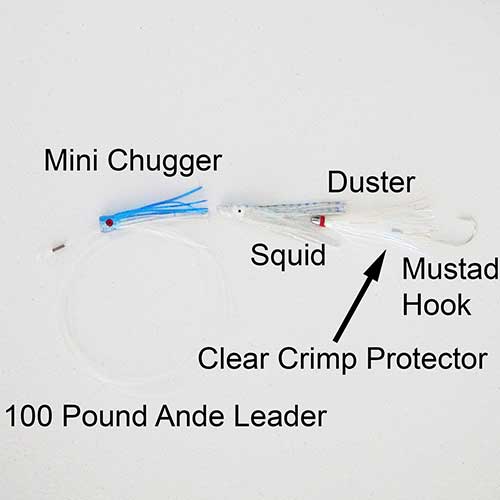
Mini chuggers used alone work ok but with a squid, pearl duster, and crimp protector these lures work even better! Adding the squid skirt and twinkle skirt duster adds color, flash, and weight to the lure. The added weight gets the chugger a bit deeper into the water making it more visible to the fish and allows it to create awesome bubble trails.
These squid skirts are 4.5 inches in length and the dusters are around 4 inches in length. The hooks are 7/0 Mustad 3407DT. A 100-pound 6-foot leader line is rigged with Ande Premium Line, chaffing gear, and crimp protector. This is exactly how I would rig up this lure as a charter captain. I prefer to run this lure a mid-distance behind the boat or on the longs, which for mahi-mahi is still not super far back.
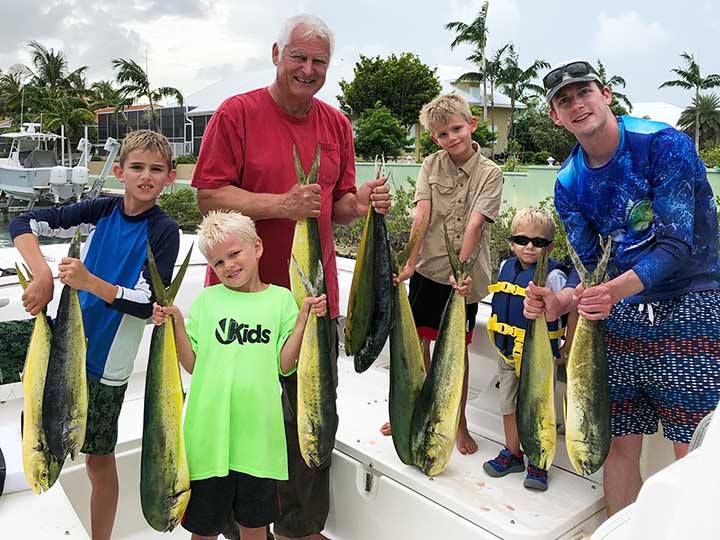
2. Chugger Head Mahi-Mahi Lure
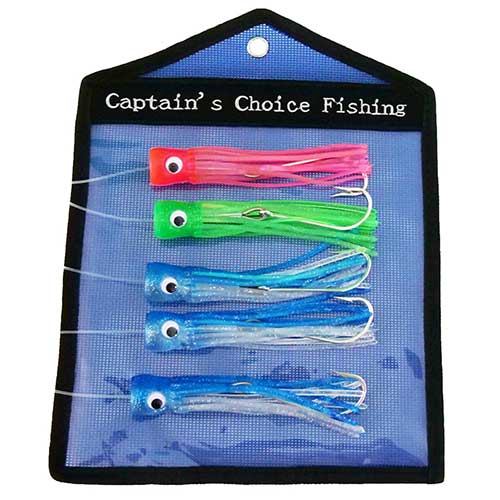
These fully rigged chuggers are six inches in length and have soft pusher heads. The colors included are blue-clear with glitter specs, green with glitter specs, and pink. These come pre-rigged with a 150-pound leader line and number 8/0 Mustad hooks. These will work great to catch small schoolies and large slammer-size mahi-mahi.
Chuggers and mini chuggers are my favorite lures to use for mahi-mahi. They can be used right in the prop wash 15 feet behind the boat or on mid-distance lines set out on outriggers. These work well without being rigged with ballyhoo but are a common skirt to place over ballyhoo. The chugger head is concave like a popper and makes noise, splashing action, and creates great bubble trails. When going offshore there should definitely be some chuggers on the boat. A great thing about these lures is they pick up fewer weeds than most trolling lures. They will defiantly still pick up weeds but not as many as heavy lures. If weeds are a major issue then run the lines closer behind the boat and slow down a bit so there is less engine turbulence.
In the video above I talk about how to catch mahi-mahi. This includes both trolling techniques and how to pitch to mahi with live bait and dead bait. The lures I am using include a chugger, mini-chugger, chugger daisy chain, nomad dtx minnow and little stubby. Good baits include ballyhoo, greenbacks, pilchards, goggle eyes, cigar minnows, and squid.
3. Daisy Chain Chugger
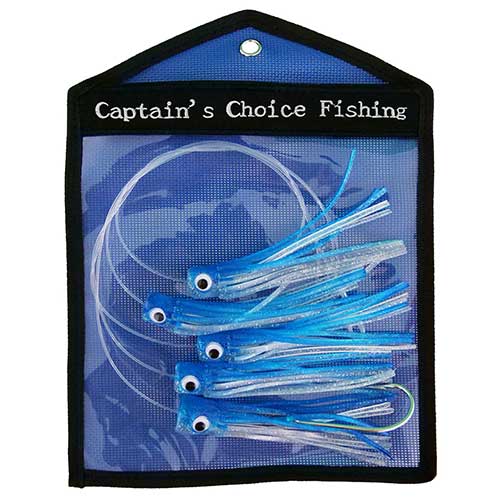
The Captain’s Choice Fishing daisy chain is a great lure and teaser for mahi-mahi. I like to use it as a teaser that is trolled a bit closer than the other lures. It is not just a teaser though as the last chugger has a hook. Mahi-mahi are aggressive fish and will bite baits very close to the boat, even when trolling.
This lure is rigged with a 200-pound line with means that it can catch the big bulls without breaking. Each chugger is 6 inches in length and even small schoolies will bite the lure. Running the lure short limits the number of weeds that get caught on the line. Typically I set this close and it is the only lure that does not catch weeds when switching sides of the weed lines. The blue clear with glitter specs is a great color and looks a lot like a flying fish.
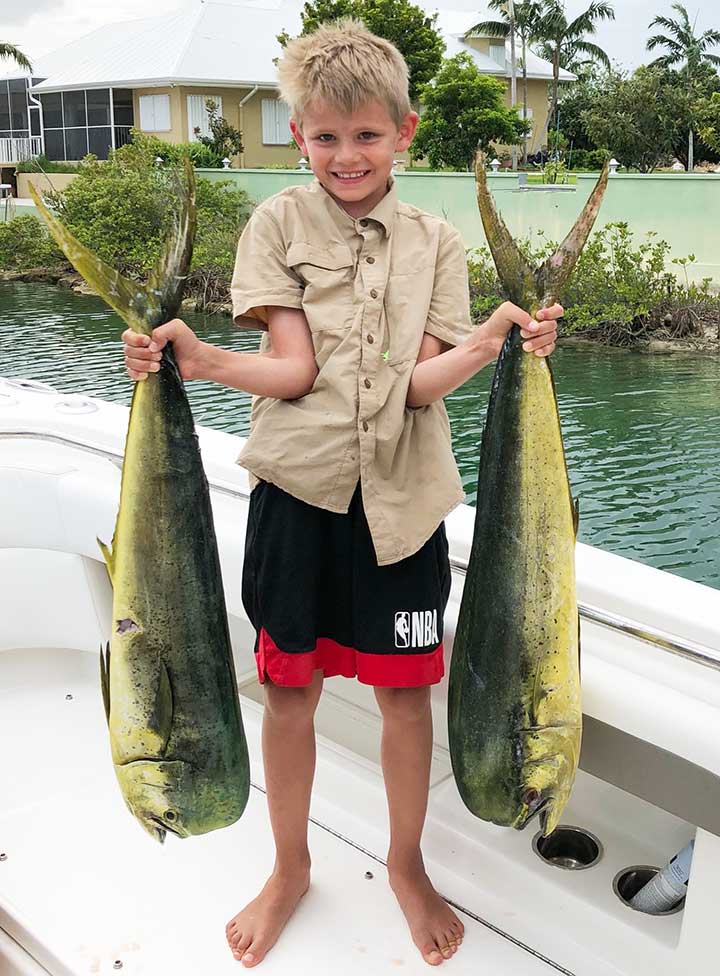
My nephew caught both of these nice bull mahi-mahi in July in the Florida Keys. One was caught on a blue/clear chugger and the other was caught on a piece of pitch bait.
4. Classic Offshore Trolling Lure
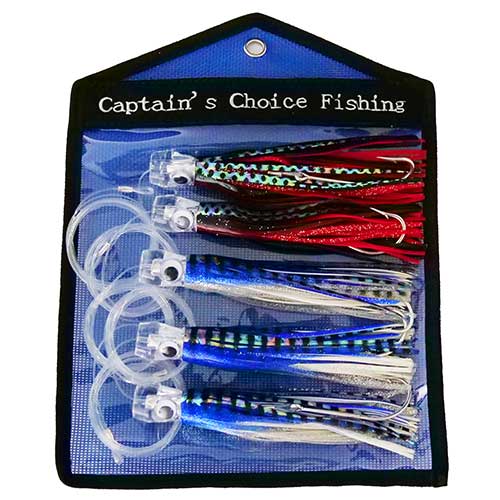
These classic trolling lures are 6 inches in length. Colors included are three blue-white lures and two black-red lures.These come rigged on a 6-foot 100-plus pound Ande line rigged with 8/0 Mustad 3407DT hooks. A blue mesh bag is included to store the lures. If you are trolling offshore and not sure which lures to used this is a great option. The lures troll well at most speeds and can catch mahi-mahi, tuna, sailfish, marlin, jacks, mackerel, barracuda, and wahoo.
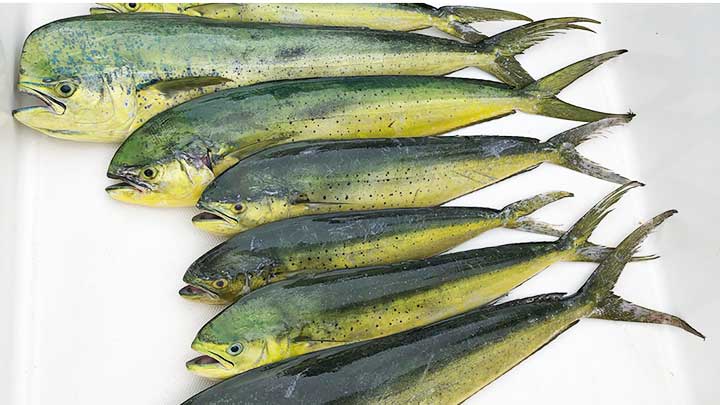
In the picture, is one bull dolphin and several female cow dolphin. These were caught offshore in the Florida keys.
5. Flying Fish Daisy Chain
The mahi-mahi daisy chain has a 6.5 inch Bost 63 Mahi Snack skirted lure with 4 flyers. This comes rigged on a 200-pound mono leader with a 6/0 heavy duty hook.
Having a daisy chain out while trolling offshore help helps attract fish into the spread and is frequently the first lure to get hit. Smaller daisy chains are typically put way back in the shotgun position. This daisy chain would work in the shotgun or on a line set a midway distance back on an outrigger. Flying fish are a favorite food of mahi-mahi and this daisy chain is a great flying fish imitation bait. This lure works as a small teaser that also catches fish.
The video above shows a common dynamic found fishing offshore for mahi-mahi. Frigate birds follow mahi-mahi until they spook flying fish out of the air. The frigate birds then swoop down and eat the flying fish. Frigate birds do not have oily feathers and can not get wet or they can drown. This is why they wait for baitfish to be brought within scooping distance of the surface.
If frigate birds are high they are either looking for fish or following fish that are not actively feeding. When they hover low to the water or are swooping near the surface there is likely mahi-mahi feeding underneath the fish. In Florida mahi-mahi usually feed swimming into the gulf stream which flows to the north. This means if a frigate bird is flying to the south it is also more likely following mahi-mahi.
Chasing birds is fun but not a guaranteed catch. Sometimes the fish are scattered and the birds are traveling so fast that you can not catch them even at a nine or ten-knot troll speed. This could mean that mahi-mahi are chasing scattered bait or that the frigate bird is following, bonito, tuna, or in the worst-case porpoises. Low slow-moving birds are the best and slowly trolling by them and pitching ballyhoo underneath and slightly in front of them has a high chance of catching mahi-mahi.
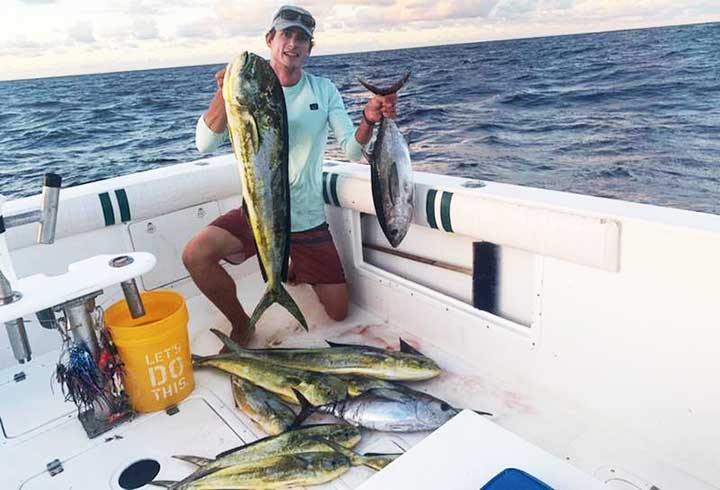
In the picture, is mahi-mahi and tuna that were caught while trolling and pitching live baits. These were caught about 20 miles offshore at the famous North Drop of St. John in the United States Virgin Islands. The North Drop is an underwater ledge that goes from 300 feet deep to 29,000 feet deep in just a few miles. In the summer this is a very popular place to fish for blue marlin.
6. C and H Little Stubby
The C and H Little Stubby is 5-1/2 inches and weighs 2 ounces. The color options include blue-white or pink-white.
This lure is lightweight which makes it good a staying weed-free and works at any distance behind the boat. It probably works the best when set far behind the boat. The lure does not look that great in my opinion by it consistently catches fish. This lure is very similar to the Williamson Dorado Catcher that I will review later in this article. I have had good luck with little stubbies so that is what I typically use. These also catch lots of small tuna.
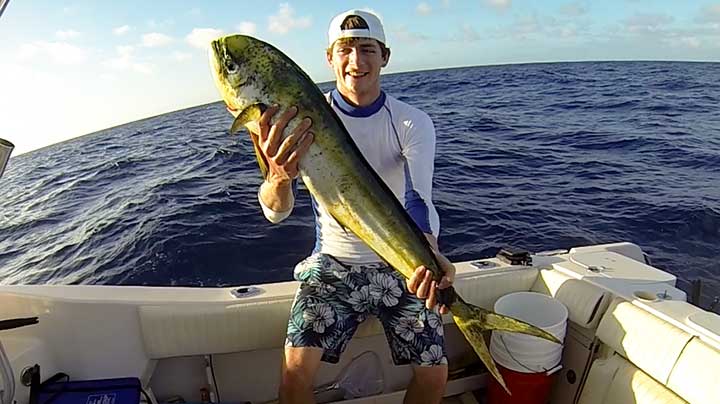
In the picture, I am holding a female cow mahi-mahi. This was caught on a blue and white little stubby while trolling along some weeds about 20 miles off the coast of the Florida keys.
7. C and H Stubby Bubbler
This C and H stubby bubbler comes in pink or purple, blue, white and has silver mylar within the skirt. The lure is 5 1/2-inches in length. Stubby bubblers come in a variety of other colors including, green-chartreuse, pink-blue, and pink-white.
This stubby bubbler can be run any distance behind the boat and will always create fantastic looking bubble trails. This lure has a plastic head and is lightweight which makes it great for staying weed-free. This lure also catches tuna, sailfish, and marlin so it is a great lure to have in the spread when fishing offshore! A strip bait can be added for scent but is certainly not
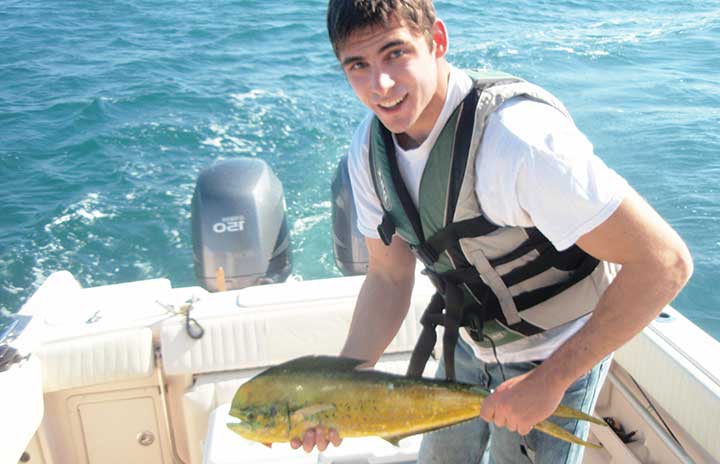
In the picture, my brother is holding a schoolie mahi-mahi. We caught a bunch of mahi-mahi that day trolling chuggers and squid baits along the edges of thick weed piles about 15 miles offshore.
8. Williamson Ballyhoo Combo
The Williamson Ballyhoo Combo has an overall length of 10-1/2 inches and weighs 15 ounces. The lure is rigged on a 6-foot 100-pound premium sufix mono leader with VMC 9/0 hooks. The ballyhoo combo comes in color options of black-purple, bonita-blue, evil-black, Holloween blue, pink-blue, and lumo-black. The lure is a sailfish catcher that is used in combination with artificial ballyhoo.
The ballyhoo combo with artificial ballyhoo is great for recreational fisherman and is effective at attracting fish. If the dead ballyhoo is not rigged perfectly the lure can spin and fish will never bite a spinning bait. Also with dead bait, you have to deal with washout which is when the belly of the ballyhoo breaks apart which makes the bait not troll properly. This is why salt is applied to the belly of dead ballyhoo. Dead ballyhoo can also be bitten in half and then trolled for a long time without a chance of catching fish. Artificial skirted ballyhoo might not be as good as a freshly baited skirted ballyhoo but it is much easier for the recreational fisherman to use and still works great.
9. Naked Ballyhoo or Skirted Ballyhoo for Trolling
Ballyhoo Trolling Bait
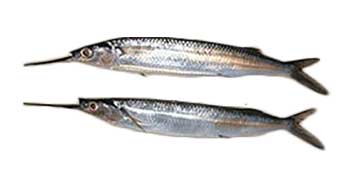
To make a ballyhoo rig for trolling start with dead ballyhoo that is fresh or that was previously frozen but thawed out. Keep the ballyhoo as cold as possible and in an ice salt brine. At a minimum salt the bellies of the ballyhoo.
Chugger Head for Skirted Ballyhoo Rig
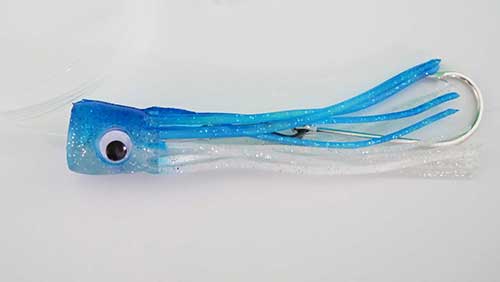
A chugger head is a great lure to place over the dead ballyhoo to make a skirted ballyhoo rig. This adds surface action to the lure and makes the ballyhoo troll more easily in the water without spinning. The skirt also helps the belly of the bait not get washed out as quickly. Other good skirts to place over ballyhoo include the dorado catcher, sailfish catcher, and Ilander Jr.
Mustad 7/0 Hook for Ballyhoo Rig
Mustad 3407 Classic O’Shaughnessy Forged Hooks are great for rigging ballyhoo. These hooks come in packs of 5, 50, or 100. These are the basic hooks that are used when fishing for mahi-mahi. For average size ballyhoo, a size 8/0 hook is the perfect size. When pitching ballyhoo with a spinning rod a 6/0 or 7/0 hook is a good size.
When making a ballyhoo rig for mahi-mahi 80-pound fluorocarbon leader line is used. A hook is tied to one end of the leader and the other end is tied with a perfection loop so the leader can easily be changed out. The line on the pole has a barrel snap swivel on it that can easily be connected to the perfection loop. This makes changing out baits fast when mahi-mahi are biting.
Ballyhoo Rig Copper Wire
This is 9-inch or 14-inch copper rigging wire. It comes with 50 copper wire strands in a clear plastic tube. Rigging wire is wrapped around the hook and then around the ballyhoo. There are many good YouTube videos about how to make a ballyhoo rig. A ballyhoo bait spring can also be used to quickly rig ballyhoo without the need for rigging wire.
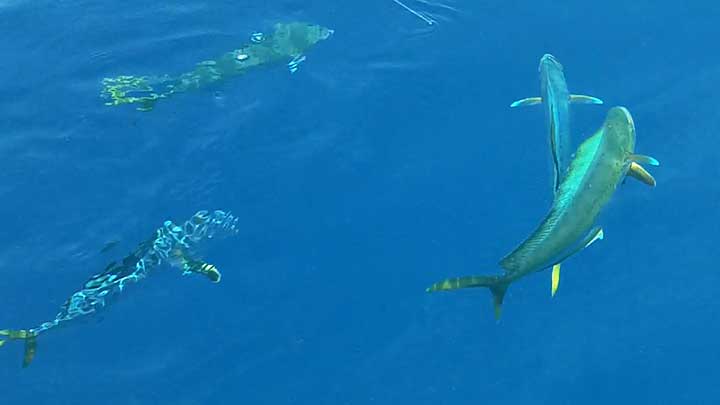
In the picture is a school of mahi-mahi about 10 miles off the coast of the Florida Keys. One fish is hooked and the other fish are staying nearby. This was in the summer and the mahi-mahi would stay close to the boat and were easily caught with pitch baits.
10. Captain’s Choice Chrome Head Mylar Skirt
Captain’s Choice Fishing chrome head mylar skirt lures are 5-1/2 inches and weigh 5/8 of an ounce. These come in colors of black/red, blue/white, and blue/pink.
These are similar to Billy Baits Mini Turbo Slammer and Boone Turbo Slammer. A great thing is that these come rigged on a 6-foot 100-pound Ande leader line which is great for tuna which have great eyesight and tend to be leader shy. The red/black color is my go-to lure when fishing for backfin tuna in the Florida Keys. Blue/white and blue/pink are good colors for mahi-mahi. These lures work great to catch mahi-mahi but are best used when the weeds are not scattered everywhere as this style of lure will catch weeds.
11. Billy Baits Mini Turbo Slammer
The Billy Baits Mini Turbo Slammer is 5 ½ inches and weighs 5/8 of an ounce, the color options include pearl-pink shimmer, pink-silver, and purple-blue mylar. These come rigged on a 6 foot of 100-pound grand slam mono leader with a 7/0 Mustad hook. The rigged billy bait comes with a rubber hook protector which spaces the hook properly and offers some protection against fish with sharp teeth.
Billy baits are great to run far back in the spread. Any skittish fish that are not willing to get close to the boat can still find these trailing in the back. They are small and will catch any size fish. If there are not a lot of weeds around these work great to catch all types and sizes of offshore fish.
12. Iland Ilander Jr
The Iland Ilander Jr is 6-3/4 inches weighs 1-3/4 ounces and has a bullet head. Color options include blue-white, pink-white, blue-chartreuse, and black-purple.
This lure runs well when rigged with ballyhoo. Using a ballyhoo bait spring is the fastest way to rig ballyhoo. The bait spring goes between the lure and the hook. The hook gets placed in the bottom of the ballyhoo and the spring then gets twisted on to the front of the ballyhoo which previously had its beak broken off. The blue-white and pink-white are great colors for mahi-mahi.
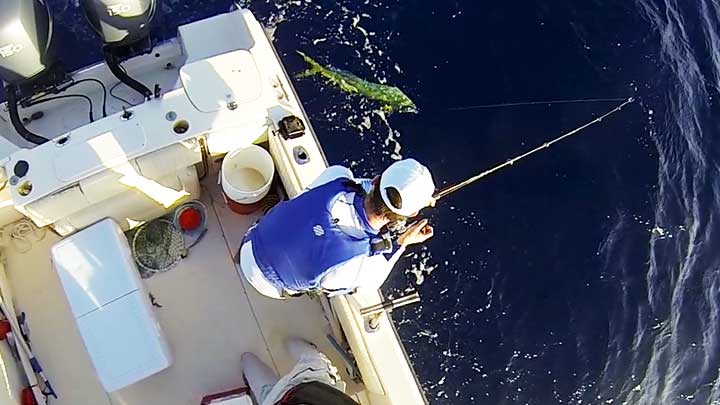
In the picture, I am reeling in mahi-mahi that was caught about 20 miles off the coast of the Florida keys. There was a good weed line and a frigate bird hovering low on our way in from fishing for tuna offshore. This was in early January and we did not see other mahi-mahi traveling with this one.
13. Williamson Big Game Catcher
The Williamson big game catcher is an 8-inch lure and weighs 2-1/2 ounces. This lure comes pre-rigged on a 5-foot 175-pound test sufix leader line with a 9/0 VMC hook. Color options include blue-pink-silver, black-purple, bleeding dorado, bonito, Halloween, Lumo, pink-white, and red-black.
I like running small baits but like having at least one large 8-inch plus bait in the trolling spread. These large baits will still catch small mahi-mahi, bonito, and blackfin tuna.
Custom Rigged 8-inch Trolling Skirt Bait
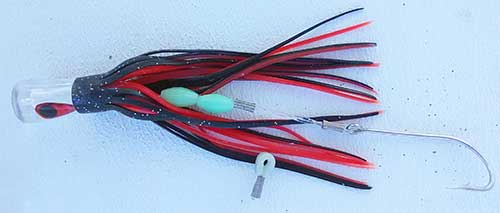
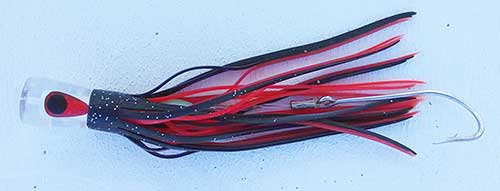
The bait rigged above is very similar to the big game catcher. Beads and crimps were used to have the hook be located just past the end of the skirt. This reduced the number of short strikes on larger baits.
14. Sea Witch on a Planer
The sea witch comes in weights of 1/8 ounce, 1/4 ounce, 1/2 ounce, 3/4 ounce, 1 ounce, 1.5 ounces, 2.5 ounces, and 4 ounces. Color options include pink-white, blue-white, and black-purple. A 1-ounce size if good to run with a planer on a fishing pole. These should be rigged with ballyhoo. This is also a great bait for wahoo so be careful where you are running this bait without wire.
Fishing Planer Size 3
The Sea Strike planer comes in size 1 which runs 5-12 feet deep, size 2 which runs 10-20 feet deep, size 3 which runs 12-25 feet deep and size 4 which runs 15-30 feet deep. The size 1 corresponds to a once weight being used at the front of the planer. There is also a size 8 high-speed planer that gets tied off to the boat and acts similar to a downrigger.
I would recommend getting a size 3 or size 4 planer when using large baits. A snap swivel from the pole connects to the front metal ring. A snap swivel with a 30-50 foot leader then connects to the back of the planer. Drone spoons are typically used inshore on planners and skirted baits like sea witches are used offshore. In both cases, these are run on 30-50 class reels.
When the planer is placed in the water the metal ring slides toward the back and sets the planner pulling down. When a fish strikes the ring slide forward stopping the planer from diving. If the planer pole releases without catching a fish, raise the rod and drop it quickly to put slack in the line. This should reset the planer to dive. When a fish bites the line tension may decrease so be ready to reel in the slack like when using downriggers.
15. Rapala Magnum 30 Diving Plug
The Rapala x-rap 30 magnum diving plug is 6-1/2 inches in length and weighs 2.5 ounces. Good color options for mahi-mahi include hot pink, bonito, blue sardine, red-head, and silver.
When fishing offshore it is always good to have one or two lines set deep. This is often overlooked by many anglers who run all surface baits. It the fish are hanging deeper in the water the deeper baits can catch their attention. Once one fish is caught it then brings the school up near the surface baits.
The easiest way to run a line deep is with a plug that has a large diving lip. Planers, as mentioned above also work to get the bait deep. However, with planers baits need to be rigged and when a fish is caught pulling in the long leader can be a pain. Especially when there is a school of mahi-mahi behind the boat waiting to be caught.
16. Mahi-Mahi Jig
Shimano jigs come in a large variety of sizes. These are fast-sinking vertical jigs. For mahi-mahi a smaller 80 gram, 2-3/4 ounce is a good size since these will be used to fish the top 150 feet of water. Good color options include black anchovie, purple-silver, and pink-blue.
These jigs are a good option to drop around floating debris and thick patches of weeds. Sometimes the fish are there but are too deep for pitch baits at the surface. These jigs are also good at catching tuna and wahoo offshore.
17. Boone Rigged Feather Baits
Boone tuna treat feathers are 6 inches in length weigh 1-1/2 ounces. These come rigged on a 125-pound mono leader. The colors include green-yellow, blue-white, Mexican flag, red-white, purple-black, and pink-white. Bass Pro Shops has Billy Baits Ahi Slayer which is the same tuna feather style lure.
The cone shape head have reflective layers to add flash to this feather bait. Some people prefer feathers to skirted baits and these are the best looking feather baits available. These can be run empty, with strip baits or with ballyhoo.
How to catch Mahi-Mahi
The key to catching the first mahi-mahi of the day is finding the birds. Sometimes finding good weed lines or debris works. However, I feel much more confident that I am going to catch fish when a warbird which is also called a frigate bird is found hovering low near the water. When a low flying frigate bird is found trolling in front of the bird while trying to directly run over the fish with the boat. Ballyhoo can be also be pitched directly underneath the frigatebird. Using binoculars or even radar can help find birds faster.
When trolling four lures are set out on 30-class conventional fishing reels. When pitching live or dead baits large spinning reels with 30-50 pound lines are. The pitch bait is usually hooked onto a 6/0 Mustad J-hook with an 80-pound fluorocarbon leader.
Once one fish is caught keep it in the water about twenty feet behind the boat until a second fish is hooked. Pitch the bait just behind the fish on the line using ballyhoo, squid, goggle eye, cigar minnow or pilchard.
Squid For Mahi-Mahi Pitch Bait
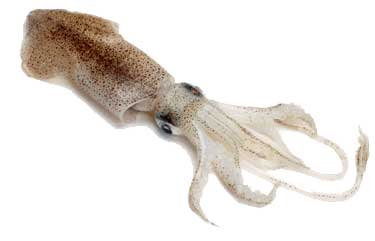
Pitching a full-size dead squid or ballyhoo is a great option when there is a school of mahi-mahi near the boat. If the mahi-mahi are small a piece of cut squid, cut ballyhoo, or shrimp can be used.
Goggle Eyes, Scaled Sardines, and Pilchards
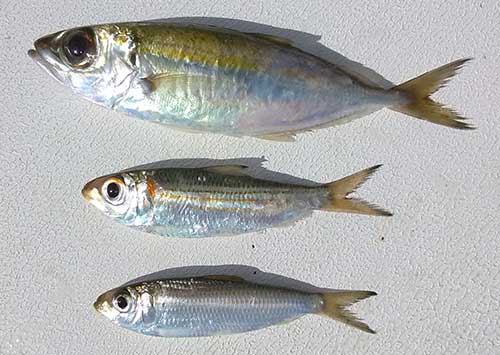
The best live bait for mahi-mahi is a goggle-eye baitfish. During sailfish tournament season goggle eyes sell for about $15 each. Goggle eyes are most often caught on sabiki rigs at night time but can also be caught with a cast net during the day. I catch all three of these baits with a large cast net. See the cast nets page to learn more about how to catch bait.
Pitching live goggle eyes or pilchards are great baits to use when mahi-mahi are behind the boat. The baits shown above are a goggle-eye, scaled sardine, and pilchard.
A size 4/0 to 6/0 J-hook with a 50-80 pound fluorocarbon leader should be used with the pitch bait. Try to keep the school around the boat by chunking cut bait or injured live bait into the school.
When trolling about four lines are typically set out. One chugger is typically trolled about 2o feet directly behind the boat. Naked ballyhoo or skirted ballyhoo is trolled using the outrigger on one side. On the other side, a stubby bubbler, daisy chain or lure set deep could be used. A small lure like a mini turbo slammer, little stubby, or small daisy chain should also be run straight on the back 150 feet or more. This catches any skittish fish and frequently catches tuna.
Make sure that lures do not have weeds on them at all times. You will not catch any fish if the lure has weeds on it. Sometimes the lures have to be continuously reeled in to remove the weeds. Running the lines a bit closer to the boat using lightweight lures helps to reduce the number of weeds that get caught on the line. It is better to have one lure it the water without weeds that 10 lures that all have weeds. Focus your energy on keeping the baits weed-free.
Cigar Minnows for Live Bait
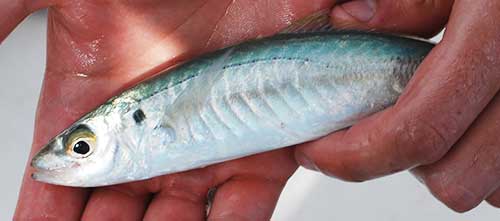
Cigar minnows are also a great live bait to use for mahi-mahi. These can be caught in grass patches on the reef by putting chum in the water and throwing a large cast net.
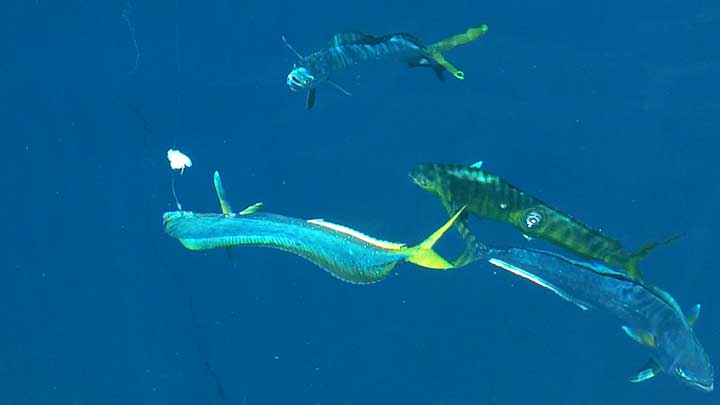
Frequently Asked Questions
How fast do you troll for mahi?
The best speed to troll for mahi-mahi is 5-8 knots when using baits with ballyhoo and 7-10 knots when using lures without ballyhoo. If I was just going to tell someone one speed to troll in would be 8 knots which is about 9 miles per hour. In reality, it is best to look at the lures and see what they look like. They should be splashing on the surface and going beneath the water. The lures should never be tumbling. Also, make sure they do not have weeds on them. Going faster and keeping lines close helps them stay weed-free. Often troll speed is referred to the RPMs of the boat. We go 2100 rpm for example. Sometimes a small change in RPMs allows the lures to be more visible relative to the boat wake.
What depth do you catch mahi-mahi?
Mahi-mahi are most commonly caught on the surface near-surface structure. The fish can be down 100 plus feet depending on the conditions but fishing lines are rarely set below 50 feet when fishing for mahi-mahi. It is a good idea to have a deep-diving plug or baited skirt on a planer to draw any deeper schools of mahi-mahi to the surface.
The overall depth of water mahi-mahi are found in ranges from 100 feet to 30,000 feet. If there is not surface structure mahi-mahi are typically found near temperature breaks where currents come together and ledges where upwelling currents can bring nutrient-rich plankton and baitfish to the surface. The predator fish like mahi-mahi are attracted to these areas because of the baitfish.
How far behind the boat should I troll?
A typical offshore trolling spread has lines set at three distances behind the boat. One line is set close about 25 feet behind the boat basically right in the prop wash. This line is easy to keep weed-free and mahi-mahi can be attracted by the prop wash and find this bait. Two lines should be sent midway back about off the sides of the boat with outriggers if available. These are typically set 90-150 feet back.
The fourth rod should be sent straight out the back and is called the shotgun rod. It is typically set 200-250 feet behind the boat. A small daisy chain is a great option for the shotgun position. A fifth line should be set not for distance but for depth. A deep-diving plug or planer should be used to get a line 15-30 feet below the surface. This line is typically set about 75 feet behind the boat.
Where do you fish for mahi-mahi?
Mahi-mahi are fish that are found offshore near the gulf stream in the Atlantic ocean. Mahi-mahi are also found offshore of California, Mexico, and Central America in the Pacific ocean. However, mahi-mahi are commonly called dolphin or dorado on the west coast. Mahi-mahi seasonally migrates thousands of miles each year and typically spawn in waters around 83 degrees. Mahi-mahi season in Florida goes from late spring until the end of summer. Some smaller mahi-mahi can be caught year-round around and good offshore structure.
What is the best bait for mahi-mahi?
The best live baits for mahi-mahi are goggle eyes, cigar minnows, ballyhoo, pilchards, and scaled sardines. The best dead baits for mahi-mahi are ballyhoo, squid, bonito chunks, and shrimp. Lures that are the best for mahi-mahi include chuggers, stubby bubblers, and daisy chains.
Are dolphin fish and mahi-mahi the same thing?
In most cases, dolphin fish, dorado, and mahi-mahi are the same type of fish species. There is a pompano dolphinfish that is found is central American that is commonly mistaken for small mahi-mahi. These are the only two fish that are in the Coryphaena genus. It is also important to note that a dolphin fish is different than a porpoise dolphin. When you tell someone that you want dolphin for dinner they often look at you with an evil grin. That is when you have to tell then you are not talking about flipper.
Is mahi-mahi fish good for you?
Mahi-mahi is a high-protein food that is full of essential amino acids and enzymes such as omega-3 fatty acids, vitamin B, potassium, selenium, and iron.
Mahi-mahi is considered a lower mercury fish. These are the fast-growing fish in the world and typically live for four years. This means there is less time for mercury and heavy metals to build up in the fish. Mahi-mahi also live far offshore away from nearshore pollution. Personally, I think this is a very safe fish to eat with mahi-mahi and small blackfin tuna being my favorite fish to eat.
Captain Cody has worked on charter fishing boats in the Florida Keys, Virgin Islands, and Alaska. Growing up in Pennsylvania Cody has also done extensive freshwater fishing including bass fishing tournaments. Cody strives to provide detailed information about the best fishing gear and tactics to help both novice and experienced anglers have a more productive and enjoyable time on the water. Cody also has a background in aerospace engineering and neuroscience but really only takes pride in being good at one thing and that is fishing!

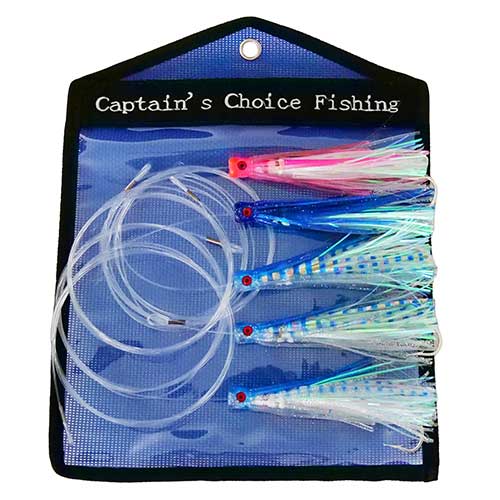
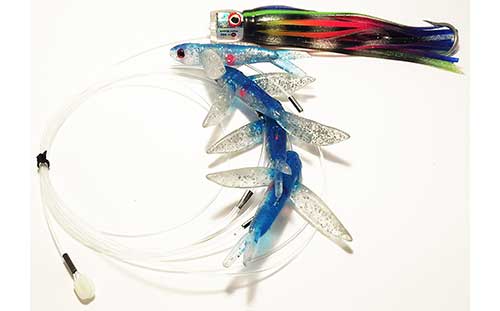
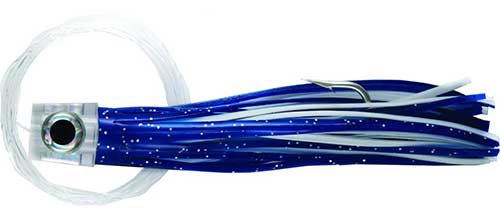
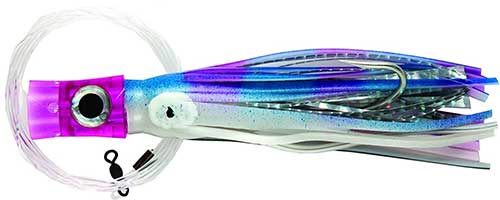
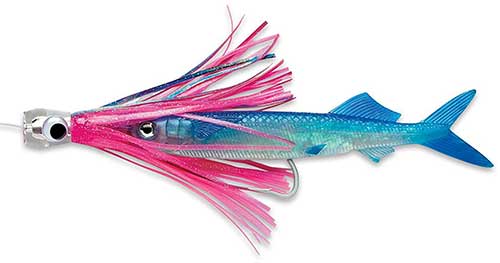
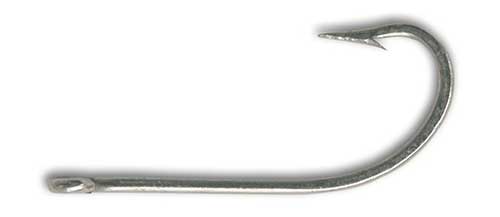

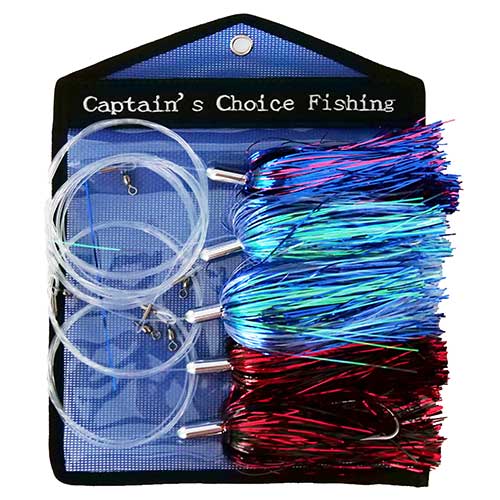
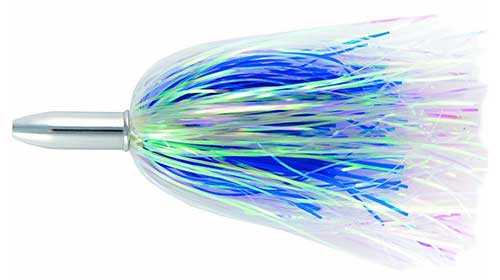
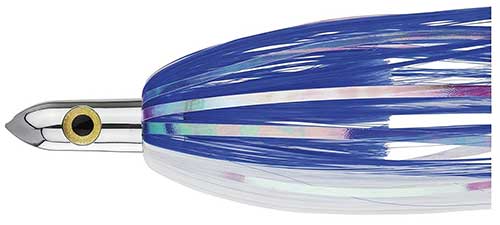
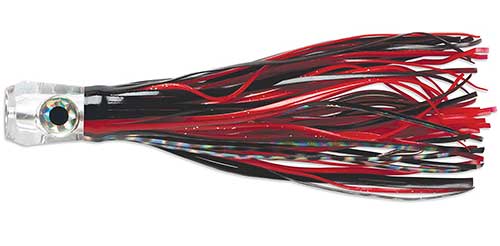
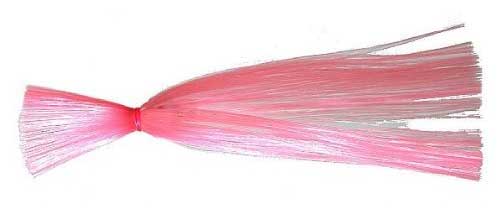
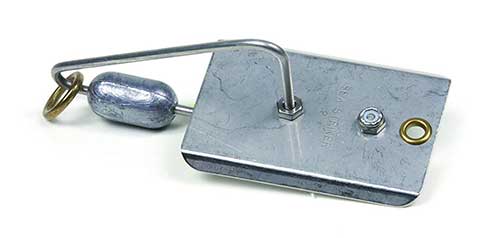


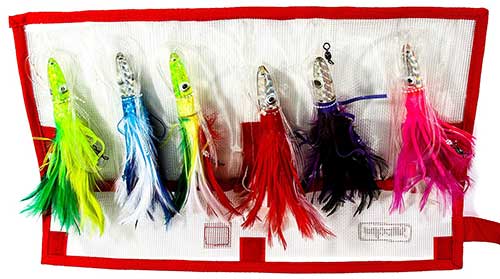
Thank you for your information in reference to Mahi fishing. It is nice to know that I am on the same page. The only difference is that I use Ilander lures in my long lines and rattles on my short lines. Thank you for your professional guidance.